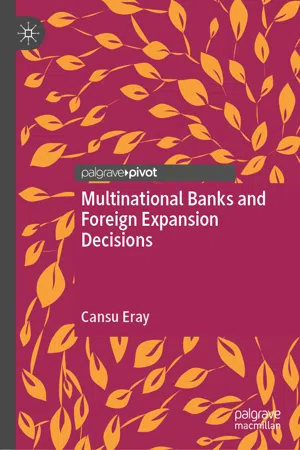Multinational banks (MNBs) described as those operating in more than one country (Hersh & Weller, 2012). The historical evolvement of their activities begun in Europe with the dominance of British banks’ overseas operations before the First World War, and it was followed by the offshore expansion of American commercial banks during the 1960s (Battilossi, 2006; Williams, 2009). Then, the foreign expansion phenomenon of MNBs has continued to grow with respect to the great wave of liberalization in the following decades. Also, the development of financial markets, technological advancements, and growing demand for banking services in recent years have encouraged further expansions to abroad with offering ample of opportunities not only for MNBs but also for host countries (Clarke, Cull, Martinez Peria, & Sanchez, 2003; Hryckiewicz & Kowalewski, 2010).
As a result of foreign bank penetration in several markets, several questions have occurred to understand this phenomenon, which leads to extensive academic literature. Many scholars examined foreign presence decision of MNBs with different research focuses and implications. The specialization level of each paper with distinctive methodologies, therefore, differs findings into separate parts of this phenomenon. Thus, a full understanding of the issue has remained undisclosed and not fully examined.
Regarding the decision-making process of those banks, for instance, several studies emphasize specific factors of host countries as well as MNBs that drive to expansion motivations based on priorities of these stakeholders (Buch, Koch, & Koetter, 2014; Cerutti, Dell’Ariccia, & Martinez Peria, 2007; Leung, Young, & Fung, 2008). On the other hand, many scholars analyze entry strategies of MNBs based on distinctive conditions (Claeys & Hainz, 2014; De Haas & van Lelyveld, 2006; Petrou, 2009) while some explain a particular entry mode regarding regional applications (Degryse, Havrylchyk, Jurzyk, & Kozak, 2012; Leung et al., 2008; Molyneux, Nguyen, & Xie, 2013). Therefore, not only differences in research questions but also methodological focuses creates ample of results in the literature. Furthermore, each study leads to further points by giving a direction for future studies. For example, the papers about entry modes of MNBs prepare a foundation for a great number of articles that work on the effects of entry strategy to the host country conditions (Boustanifar, 2014; Claeys & Hainz, 2014; De Haas & van Lelyveld, 2006; Li, Zeng, & Zhang, 2013; Van Tassel & Vishwasrao, 2007; Xu, 2011). Thus, an extension of literature results in difficulty for researchers because comparing findings of several papers to reach a consensus takes great time and effort.
The aim of this study, therefore, is to link the theoretical considerations of several valuable research in the MNBs foreign expansion literature by establishing a bridge within a structured framework. Mapping and assessing this fast-growing literature stream are important for both practitioners and scholars because of two reasons. First, they can develop a better understanding, thanks to having an overview of the issue. Second, they can investigate the applications of relevant studies deeply within a short timeframe. Moreover, this study reveals the gap in the literature by emphasizing vague points for further studies. To the best of existing knowledge, the last review for foreign banking area has been done by Clarke et al. (2003), and this book takes this study one step further by updating results with recent studies from 2003 to 2018, having a wider scope, using a systematic review methodology, and applying an integrated framework.
To achieve the objective through analyzing foreign expansion decisions of MNBs deeply, the study attempted to answer such questions: What are the main factors that drive MNBs to expand abroad? Which entry mode is preferred with respect to different market conditions? To what extent the chosen entry mode affects the host country? By answering these questions, this phenomenon can be investigated from the beginning of the process to further implications.
Regarding the review procedure, out of 141 identified papers, the study analyzed 28 studies that matched the criteria of systematic search. Then, it synthesized these papers based on the review scheme that split study’s focus into three different areas with the logic of “
Reasons-
Phenomenon-
Consequences” to link the concepts within an integrated framework:
Drivers of foreign expansion,
Entry mode decisions of MNBs, and
The impacts of foreign presence into host country regarding the chosen entry modes.
According to the results of the study, the reasons for the foreign expansion of MNBs generally related to locational and ownership-specific factors. The location-specific factors compromise the integration level of countries, the market opportunities, and host country regulations while the ownership-specific factors include the size, efficiency and performance level, and home country’s legal framework. Based on these drivers, MNBs determine priorities in the distant market and choose the proper entry mode to leverage the greatest benefits.
The entry mode decision, as to the phenomenon in the research, has multiple strategies which investigated in this book according to their applicability and benefits. There are three main entry modes as cross-border lending, greenfield investment, and acquisition. Since each entry mode has its benefits and challenges, choosing the right entry strategy has a crucial importance on obtaining the highest benefits in the abroad. As an illustration, cross-border lending strategy offers asset safety in less-developed banking markets with ease of exit while greenfield investment gives a greater market share in developed markets thanks to having a legal presence in the host country. On the other hand, acquisition entry helps to leverage market knowledge about borrower’s quality in less-developed banking markets that have informational barriers (Lehner, 2009).
Fi...
